The BMW 8 Series E31 is one of those cars that has definitely matured with age. Launched in 1989, with a high-tech fanfare, the new model wasn’t received with quite the enthusiasm that BMW had hoped for; it was quite a different beast to the E24 6 Series that it replaced.
While the 850i E31 was undoubtedly a wonderful showcase for BMW’s latest technology, it was criticised for being slightly too sterile and less fun to drive than the outgoing car. In truth, BMW’s focus with the 8 Series was to take the model further upmarket and, as a result, it had created a luxury grand tourer, rather than a sporting Coupé.
WEIGHTY MODEL
Initially, it was only available with the new M70 V12 that had made its debut in the E32 750i and, while you’d have thought that a 300hp, 5.0-litre V12 would have provided pretty stunning performance, the reality was that the E31 was a relatively heavy vehicle, so it wasn’t as fast as might have been expected.
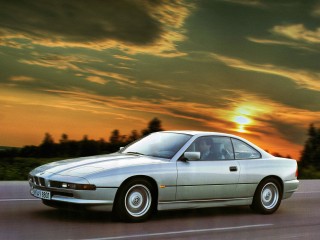
While the V12 was a super-smooth unit, it only confirmed that the Eight was much more of a GT than the old E24 had been. It just wasn’t quite as characterful as the old M30 and M88 ‘sixes that had been the staple of the 635/M635 range. The 8 Series was, however, a technical tour de force, and BMW chose to use it as a mobile showcase for all of its latest technology. There was new multi-link suspension with passive rear-steer (later upgraded to Active Rear-Axle Kinematics), electronic damper control, ASC+T traction control, multiplex wiring, Servotronic steering and the first six-speed manual gearbox on a production car.
The 8 Series in its element; cruising along the autobahn.
Also of note were the electric windows that would lower a fraction when the handle was pulled to open the door, then rise again once the door was closed, to ensure a good weather and wind seal at high speed. We’re all used to this feature in BMW coupés nowadays of course but, in 1989, this was seen as a real technical innovation.
GROUND-BREAKER
The E31’s styling was a significant departure from the norm – remember this was the era of the BMW E30, BMW E34 and BMW E32 – and the new 8 Series brought smaller kidney grilles integrated into the nosecone, pop-up headlights and a very sleek look, almost completely unadorned with any fripperies. Inside, everything was new, too. Although some stalks and switchgear were carried over from other models, the centre console and instrument cluster were entirely new designs. The dials weren’t what we’d come to expect from BMW, and the speedo and rev counter actually overlapped – another first for the company.
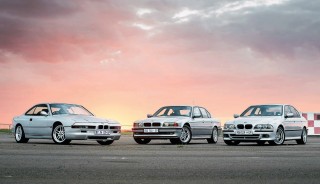
Despite being a similar length to the outgoing E24 6 Series, the Eight’s rear seats were actually smaller than those in the E24 – you’d really struggle to fit anyone in for all but the shortest of journeys. The boot had also shrunk – by nearly 100 litres when compared to the 6 Series – somewhat denting the E31’s GT credentials. But, perhaps worst of all, the new model was more than 300kg heavier than the Six; something that had a clear effect on its dynamic properties.
While it might have had a slightly lukewarm reception when new, today the 8 Series represents a brilliant classic GT, but you’ll need to be quick to snap-up a bargain as prices are on the rise. You’ll also need to be careful as, like many cars of this sort, the 8 Series certainly went through the phase of being very cheap to buy.
Consequently, it fell into the hands of owners who fancied the idea of owning a flash motor, but didn’t necessarily have the required funds to keep it in fine fettle. Conversely, there are the low-mileage, cherished machines that should need little or no work before they’re put to use… it’s all a matter of sorting the wheat from the chaff.
THREE CHOICES
Buying choices are more or less limited to three models for those of us based in the UK – 850i, 850CSi and 840i –– and each has its pros and cons. The 850i was the original launch car and, as already mentioned, used the M70 V12 that offered 300hp and 332lb ft of torque and delivered a 0-62mph time of 6.8sec for the manual (7.4 for the automatic). In late 1992, BMW launched the 850CSi and this was perhaps the car the Eight should have been from the start.
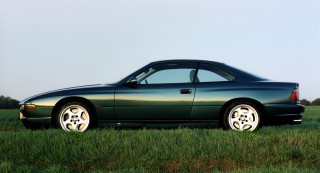
It was an M car in all but name (it even had an M WBS chassis number), and packed a 5.6-litre V12 developing 380hp and 405lb ft of torque; enough to drop its 0-62mph time to 6.0 seconds. At the same time, the 850i gained a Ci moniker, which shouldn’t be confused with the later 850Ci that used the 5.4-lite M73 V12, and wasn’t officially offered in the UK.
Although the natural successor to the E24 6 Series, the styling of the 8 Series was a radical departure and, as a result, came as quite a shock to many at the time.
The last model to enter the fray was the 840Ci and, initially, this used the M60 4.0-litre, V8 (286hp and 295lb ft). Its performance figures were just about on a par with the 850i but, pretty quickly, the V8 was updated to M62 4.4-litrespec, which gave the same 286hp, but offered a little more torque (310lb ft) and greater flexibility.
The 8 Series is a cracking machine; one that’s entertaining to drive on the right roads
The 840Ci Sport was launched late in the day, and it featured the same styling upgrades as the BMW 850CSi E31 – deeper front spoiler, rear diffuser, Sports seats, a Sport steering wheel, M door mirrors and 17in M5 ‘Throwing Star’ alloys.
LOOKING FOR TOUBLE
The 8 Series was a complicated car for its day, so there’s lots to go wrong now. So, if at all possible, I’d advise getting an inspection carried out on any prospective purchase by a BMW specialist who knows what they’re looking at. However, before calling on an expert, there’s plenty you can do to help identify good from bad.
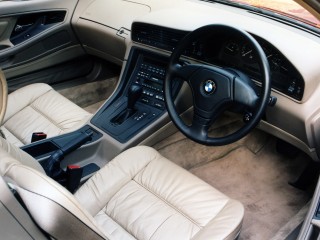
Start with the bodywork, as even apparently minor defects can be expensive to fix. First of all, examine the nosecone carefully, especially around the kidney grille area. There’s no bumper to prevent bodywork damage, and the delicate section in between the two kidneys can easily get broken. It’s tricky to repair properly and, if there’s significant damage, a new nosecone will be required –more than £650 new from BMW, before painting and fitting.
A comfortable interior was an 8 Series given, for front-seat passengers, anyway. Those in the back endured a decidedly cramped time.
Examine the headlights and panel gaps around them when they’re open and closed, and check the headlights themselves for damage. While you’re there, inspect the front indicator/side light housings in the front bumper, as these are no longer available new, although used replacements can be sourced… for around £300 each. If you’re looking at a Sport, then make sure the front lower spoiler isn’t damaged, they’re very susceptible to clonking kerbs.
RUSTY EXAMPLES
As you work your way down the car, check the lower section of the doors for rust, as well as the rear wheel arches. They can also succumb to tin worm along the top of the front screen, and also along the leading edge of the sunroof. While you’re checking the doors, make sure they open properly from both inside and out, as outer door handles are also no longer available.
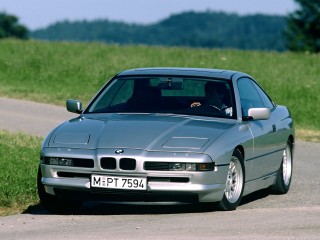
At the back of the car, have a look at the rear light cluster… yup, they’re also no longer available. Another check point at the back is the rear screen, which tends to go ‘milky’ as water works its way into the sandwich. This can also corrode the heated rear window elements, which will eventually stop working. A new screen from BMW costs about £900, but there are cheaper alternatives available from glass specialists.
The E31 8 Series can be fun to drive on a twisty road, but its real strength is as a GT cruiser.
Inside the car it’s a case of checking that everything works and that none of the trim is damaged – not a disaster, but potentially costly and time-consuming to put right. Look for pixels that aren’t working on both the mileage readout section in the dash cluster, as well as on the OBC, contained in the centre console. You’ll be looking at about £100 for each repair, and that’s assuming you do the removing and installing yourself.
Spend some time in the driver’s seat making sure the electric windows all go up and down smoothly, and that the electric seats operate in all directions. Seized motors are common, especially if the car has been stored in damp conditions. Ensure the air conditioning works and that the fan operates at all speeds – a new fan ‘sword’ can cost £500 to replace.
WARNING SIGNS
Another check to be made from inside the car is to make sure that the ABS and ASC lights come on with the ignition, then are extinguished soon after the engine has been started. If they don’t (and this will be an MoT failure), then it’s most likely that the ABS pump/hydro unit has failed.

This isn’t a pleasant part to replace and, depending on the model, may no longer be available from BMW. As a price guide, I found one at an eye-watering £1,250, but a switched-on Bosch agent may be able to source an identical unit for significantly less.
The 840Ci was the final model to enter the fray, and was initially powered by the M60 4.0-litre, V8. But this was soon changed to the M62 4.4-litre – same power, more torque.
Don’t forget to operate the wipers because, if they don’t run smoothly – or park properly at the end of their sweep – the linkage could be at fault. The good news is that the linkage is still available… the bad news is that it’s £487, although you may be able to purchase a secondhand one much cheaper.
The heart of any BMW is its engine, and the ones fitted to the E31 8 Series aren’t too bad. However, the 4.0-litre M60 V8 earned itself a bad reputation back in the day for failing Nikasil bore linings, leading to excessive oil consumption and rough running. You’re unlikely to encounter it today, as cars that have made it this far are unlikely to suffer from it now, but if you are looking at an early 840Ci, then do bear this in mind.
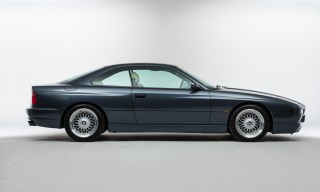
Sticking with the V8 for the moment, look out for leaking cam cover gaskets which can lead to a misfire, as it’ll affect the coils. Timing chains can get a little vocal due to tensioner problems, and the plastic guides can also break up as mileage and age both advance. Other potential problems to watch for are failing alternators (they’re water-cooled and so not cheap) and a non-start fault can be down to a failed starter motor. It’s also worth watching out for a lumpy idle that’ll most likely be caused by vacuum leaks – throttle body gasket, PCV valve and manifold gaskets.
While the E31 represented something of a styling revolution when launched, and the initial reception wasn’t as warm as BMW had hoped for, the model has matured into an attractive and distinctive classic.
V12 COMPLEXITY
The V12s are naturally more complicated, and even simple tasks, like changing the plugs, can prove a daunting and time-consuming job. Throttle motors used to be a real weak point on these engines – there’s one for each bank of cylinders – and if you need a pair they’re a second mortgage-inducing £1,990… each.
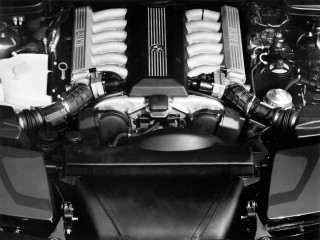
Fortunately, they can now be rebuilt for significantly less than that. Other common V12 problems include oil leaks, particularly the sump and front timing cover, and this engine is also prone to leaking manifold gaskets, causing rough-running.
As is typically the case with a BMW, the 8 Series was all about its engine. Nothing smaller than a 4.0-litre V8 was to be found under the bonnet so performance, while not eye-watering, was always snappy yet refined.
If that little lot hasn’t put you off, then you also need to listen out for noisy tappets on the V12, which can become serious if ignored. It’s a lack of lubrication that triggers the initial problem, as a result of the banjo bolts becoming loose – very similar to the problem that affects the old M30 straight-six.
If caught early, the banjo bolts can be replaced and, hopefully, not too much damage will have been done to the cams. But if the situation has gone unattended for too long, then you’ll be looking at new cams and potentially seized rockers. If in doubt about this issue on a prospective purchase, just walk away as it’s simply not worth the risk.
HOT PROSPECT
All E31s, like most other contemporary BMWs, can have cooling system issues. Water pumps can fail, thermostats can leak or jam either open or closed, radiators can expand; there’s lots to go wrong. Obviously, you can only protect yourself so far here, as you can’t take a water pump out to see how it’s faring. But you can look to see if a radiator is bulging at its base, you can check to see if the viscous fan clutch is operational, and you can examine the expansion tank for leaks. In fact, check everything you can for any signs of leakage.

Transmissions are, generally speaking, pretty reliable. Manual versions are exceedingly rare in the UK, so most you find for sale will be equipped with the five-speed auto. It’s a pretty tough unit, but will no doubt benefit from a fluid change. On higher mileage machines the ‘boxes can fail, but they can be rebuilt by a competent gearbox rebuilder; they’re nowhere near as complex as the later six-and eight-speed transmissions.
Pop-up headlights were just one of the many firsts for BMW with the E31 8 Series; the company really did throw the technological sink at this one!
As the E31 is a pretty heavy old beast, it has a habit of knocking suspension bushes out at a fairly alarming rate and, while none of them are desperately expensive components, if you end up having to do them all at the same time, you’ll be facing a four-figure bill, possibly starting with a ‘2’ if everything needs replacing.
SUSPENSION WOES
The 8 Series can also suffer from the dreaded ‘shimmy’ that can be felt through the steering at 50-60mph. While this can often simply be a case of replacing worn components, some owners do end up pulling their hair out trying to find the precise cause – upper arm bushes and lower arms are often, but not always, the culprits.
Other potential problems can include (but aren’t limited to) front shock absorber failure. These are unique to the 8 Series, but can be replaced by Bilsteins, at around £450 a pair. Rears are slightly cheaper, but it’s also worth checking the rear coil springs as they’re known to snap. If replacing any components at the back, it’s also worth fitting rear shock tower reinforcement plates as, given time, the rear towers have been known to split.
BMW’s focus with the 8 Series E31 was to take the model further upmarket
If you’re looking at a CSi, then you need to make sure its AHK (Aktive Hinterachskinematik, or Active Rear Axle Kinematics for us Brits) rear wheel steering set-up works properly. It was briefly offered on the 850i and early 840i, too, but was rarely optioned. On balance, this is probably best avoided, as problems can be very hard to trace and expensive to put right. The arrival of DSC saw the system being dropped in 1994.
Today the 8 Series represents a brilliant classic GT, but you’ll need to be quick to snap-up a bargain
The E31’s weight means you’ll want to make sure the brakes are up to scratch. They can suffer with seized, or partiallyseized front callipers, especially on cars that have been left unused for periods of time. New callipers from BMW are £406 each, but most will be rebuildable. Front discs are £96 each from BMW, but cheaper from the aftermarket.
DOUBLE-TROUBLE
The E31 can suffer from electrical maladies, too, and it features not one, but two, batteries in the boot, and both need to be maintained in tip-top condition for the car to operate properly. Other boot-based electrical problems, such as the lights mounted on the boot lid not working, can be down to broken wiring where it enters the boot lid.
Overall, the 8 Series is a cracking machine; one that’s entertaining to drive on the right roads. From a visual point of view, the car’s styling has matured very, very well with age, to the extent that it’s now seen as a better-looking machine than it was when new.
The 8 Series was a complicated car for its day, so there’s lots to go wrong now
When you’re buying privately, it’s very much a case of assessing the owner as well as the car. Does the seller look like they’ve been lavishing love (and more importantly, money) on their 8 Series? Do they have a stack of invoices to go with the car? Is it fitted with matching, good-quality tyres? All these will provide very useful insight into how good the car might be as an ownership proposition.
Buy a bad 8 Series, though, and you’ll become as equally familiar with your local BMW parts counter as you will with your bank manager. On the other hand, buy yourself a good one and you’ll be all set to waft, imperiously around town, receiving admiring glances at every turn.
WHAT TO PAY?
The days of the £3,000 E31 have long gone I’m afraid but, to be honest, cars at that price level would always have been a heap of trouble, leaving you with the Ultimate Garden Ornament rather than the Ultimate Driving Machine.
Today, the majority of cars seem to start around the £10,000 mark, judging by what I’ve seen being advertised. However, they do sometimes sell for less than this at auction so, if you’re after a cheaper Eight, then perusing the classic auction catalogues could well be the way to go.
The majority of cars for sale are 840Cis, and a good proportion of these are typically the later, Sport model. It seems to be the one that most people are after so, if you can live without the body kit, you might be getting something of a bargain. While some 840Cis seem to be advertised for sale at about the £20,000 mark, I don’t think that this is really justified, especially if you consider prices at auction.
Anglia Car Auctions, for example, recently sold a 1999 840Ci Sport in Oxford Green, with silver-grey leather and 60,000 on the clock and a full history, for £14,400. That seems very good value for money to me.
As always, look at as many cars as you can, and get a good feel for the market. Oh, and if you’re after an 850CSi, I’m afraid they’re now starting at around the £50,000 mark.
8 SERIES TIMELINE
1989 850i launched with 5.0-litre V12. Standard equipment included electric leather seats, front fog lights, 12-speaker stereo and five-speed manual gearbox (or optional, four-speed auto).
1992 850i rebadged as ‘850Ci’. Six-speed manual becomes standard, while five-speed auto replaces four-speed gearbox on the options list. 850CSi launched, powered by a 5.6-litre V12 producing 381bhp and 406lb ft of torque; available as a manual only, with LSD, E34 M5 wheels, brakes, aero kit, Sports seats and uprated steering and suspension.
1993 840Ci launched. This entry-level model featured a 4.0-litre V8 from the E34, producing 286bhp and 295lb ft of torque. Performance only slightly down on the 850Ci, despite smaller engine. Handling better thanks to lighter nose, contributing to a generally more sporting feel. Five-speed auto is standard, and standard equipment levels are generous with almost all the same toys as the 850Ci.
1994 840Ci gets six-speed manual in addition to auto. 850Ci engine enlarged to 5.4-litres, producing 326bhp and 361lb ft of torque. The 850Ci with 5.4- litre V12 not sold in UK.
1995 850Ci and 840Ci both get Steptronic transmission. 850Ci is withdrawn from sale in all markets, apart from continental Europe.
1996 850CSi production stops, with just 1,510 cars produced in total, of which only 160 were right-hand drive. 840Ci now powered by 4.4-litre V8 and, while power remains the same, torque is up to 310lb ft.
1997 840Ci Sport goes on sale, with 850CSi aerodynamic kit, E34 M5 wheels, Sports seats, Sports steering wheel and M door mirrors. Despite additions, price is identical to standard 840Ci.
1999 8 Series production ends.
Perhaps the ultimate iteration of the 8 Series, the BMW 850CSi E31
| Car | 840Ci (4.0) | 840Ci (4.4) | 850i/Ci | 850Ci | 850CSi |
| Engine: | V8, M60 B40 | V8, M62 B44 | V12, M70 B50 | V12, M73 B54 | V12, S70 B56 |
| Capacity: | 3,982cc | 4,398cc | 4,988cc | 5,379cc | 5,576cc |
| Power (hp) | 286@5,800 | 286@5,700 | 300@5,200 | 326@5,000 | 380@5,300 |
| Torque (lb ft) | 295@4,500 | 310@3,900 | 332@4,100 | 361@3,900 | 406@4,000 |
| 0-62mph (secs) | 6.9(m), 7.4 (a) | 6.6 (m), 7.0 (a) | 6.8 (m), 7.4 (a) | NA (m), 6.3 (a) | 6.0 (m), NA (a) |
| Top Speed MPH / KPH | 155 / 250 | 155 / 250 | 155 / 250 | 155 / 250 | 155 / 250 |
| On sale: | 1992-1996 | 1995-1999 | 1989-1994 | 1994-1999 | 1992-1996 |





